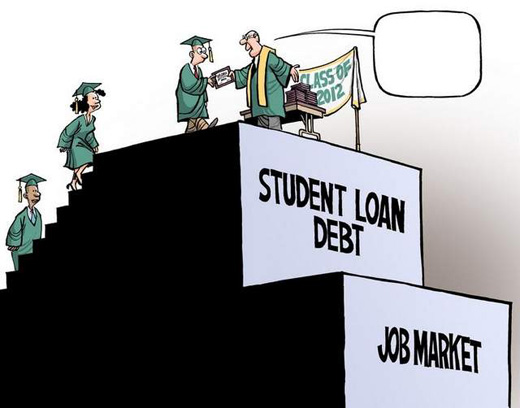
The depressed state in which many students find themselves while glancing into their bank accounts is relieved by the promise of opportunity in the private sector? If this promise is legitimate, as many Americans believe, than the topic of conversation in the mainstream media should not be the student-loan crisis, but rather the usefulness of a well-educated worker. But the fact is that many graduates are failing to find work, and this should be taken very seriously. So, too, should an examination of why our economic values restrain employment opportunity.
Does a student-loan crisis not suggest that recent graduates and current students alike struggle to a find path to debt repayment? Perhaps no path is being offered. According to the Bureau of Labor Statistics (BLS), 26% of graduates are unemployed and 37% are what is called mal-employed, meaning the jobs they currently have do not require a college degree, i.e., waiting tables, working in retail – minimum wage jobs. In other words, over 60% of the most recently educated minds in America have no immediate way of paying off their loans. More disturbing yet are the disclosures these percentages fail to include:
“In May, 2.1 million persons were marginally attached to the labor force, essentially
unchanged from a year earlier. (The data are not seasonally adjusted.) These individuals
were not in the labor force, wanted and were available for work, and had looked for a
job sometime in the prior 12 months. They were not counted as unemployed because they
had not searched for work in the 4 weeks preceding the survey.” (BLS May 2014 summary)
Its central point underlines the fact that many graduates have lost hope – no longer bidding for a part in the general workforce. Though the Obama administration has recently taken steps to combat the burdensome student debt by reducing monthly payments on government-issued loans, most graduates are spending their first years out of college unemployed or without proper resources – rendering this “help” insignificant. Also, the federal assistance programs and reduced monthly loan payments do not affect private loans issued by banks – which for most students make up the largest portions of their debt.
The average student-loan debt, according to College Access and Success, is $29,400. An obvious consequence of debt is that it destroys the ability to truly invest in the economy. Graduates are dissuaded from purchasing homes, buying a new car, having children, and are even less likely to get married; the combined debt is, for most, just too much of a financial burden. This is demonstrated in studies published by The Wall Street Journal as well as other arms of the business press. Because of the demands that debt entails, essential economic activities are suspended. This forces our economy to work against itself – contradicting the “free market” principles on which it is allegedly based. Students and graduates are corralled by crippling debt into making financial decisions out of necessity rather than out of desire. They aren’t purchasing homes, investing in their future or focusing on community involvement. The debt insists that they work for money, rather than for societal improvement.
But student debt is of course encouraged by the business community. It is enforced and engineered in such a way that if students try to avoid this debt altogether, they wind up segregated to lower wages. For example, some students try to pay for college piecemeal – only taking classes when they can “afford” them. Those who take this path are not earning the salaries that derive from having a college degree. Instead they are working low-paid jobs in stores, restaurants and so on. If students pay for their food, car insurance, gas, rent, etc., and have money left over to pay for a college class, then they are just sustaining themselves, rather than getting ahead. Fragmenting the cost of tuition in this manner also only prolongs their degree: a four-year degree takes maybe six years; a six-year degree may take eight. This means students are shackled to low-paying jobs for longer periods of time – again, working these jobs out of necessity rather than desire. This is the only alternative to student-loan debt.
It could be argued that this is the smartest direction for students to take, but look at the impact on the economy. Spreading tuition payments out over several years slows economic growth, and those who do take this path still face mal-employment. The unemployment levels reported by the Labor Bureau take all graduates into account, regardless of how they managed to pay for college.
Colleges, even public ones, are operating like businesses. And like all businesses, they are adapting themselves to whatever brings a profit. As soon as students gain some kind of financial assistance, they find that the cost of tuition is increased. This situation is only defended by those advocating “free markets.” It’s an expression of the overall “market” philosophy innate to the American brand of capitalism. If there is a market that can be lawfully exploited through this economic system, then it will be. Colleges are one prime example. The government, instead of setting and regulating tuition costs, allows the “free market” to determine the price of higher education and thereby determine the country’s direction. By handing out billions of dollars in loans to students, it only perpetuates the problem. This dysfunctional system is not debated in mainstream media.
Our government does have the collective responsibility of understanding, as Jefferson did, that higher education is, indeed, a worthwhile undertaking. Through investing in education, our country has invested billions in the quality of workers it produces. Yet the corporatization of the university has perverted government initiative for the sake of larger profits. Unless college institutions are nationalized or tuition costs heavily regulated, colleges will have no reason to lower their prices. Asking a business to reduce costs just for the sake of doing it is hardly incentive. When universities are given free rein to impose whatever costs they like, they charge the public as much as possible.
The crisis of college costs and student debt is a reflection of capitalism’s inherent tendencies, which poke at the wounds of an already injured economy. Unfortunately capitalism’s romanticized portrayal in the mainstream media protects it from any real criticism. If we are going to discuss ways in which we might go about fixing this problem, then the legitimacy of our current economic system and its values must also be challenged.
Charles Stevens is a writer and recent college graduate in Tennessee.
Image: marsmettnn tallahassee CC

MOST POPULAR TODAY


Zionist organizations leading campaign to stop ceasefire resolutions in D.C. area

Afghanistan’s socialist years: The promising future killed off by U.S. imperialism

High Court essentially bans demonstrations, freedom of assembly in Deep South

Communist Karol Cariola elected president of Chile’s legislature






Comments